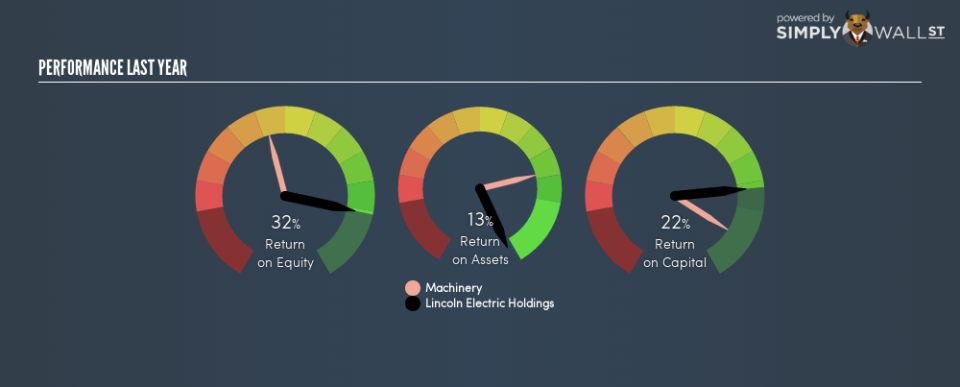Why You Should Like Lincoln Electric Holdings, Inc.’s (NASDAQ:LECO) ROCE

Want to participate in a short research study? Help shape the future of investing tools and receive a $20 prize!
Today we’ll evaluate Lincoln Electric Holdings, Inc. (NASDAQ:LECO) to determine whether it could have potential as an investment idea. In particular, we’ll consider its Return On Capital Employed (ROCE), as that can give us insight into how profitably the company is able to employ capital in its business.
First up, we’ll look at what ROCE is and how we calculate it. Second, we’ll look at its ROCE compared to similar companies. Last but not least, we’ll look at what impact its current liabilities have on its ROCE.
Return On Capital Employed (ROCE): What is it?
ROCE is a measure of a company’s yearly pre-tax profit (its return), relative to the capital employed in the business. In general, businesses with a higher ROCE are usually better quality. Overall, it is a valuable metric that has its flaws. Author Edwin Whiting says to be careful when comparing the ROCE of different businesses, since ‘No two businesses are exactly alike.’
So, How Do We Calculate ROCE?
The formula for calculating the return on capital employed is:
Return on Capital Employed = Earnings Before Interest and Tax (EBIT) ÷ (Total Assets – Current Liabilities)
Or for Lincoln Electric Holdings:
0.22 = US$401m ÷ (US$2.3b – US$538m) (Based on the trailing twelve months to December 2018.)
So, Lincoln Electric Holdings has an ROCE of 22%.
Check out our latest analysis for Lincoln Electric Holdings
Does Lincoln Electric Holdings Have A Good ROCE?
One way to assess ROCE is to compare similar companies. In our analysis, Lincoln Electric Holdings’s ROCE is meaningfully higher than the 12% average in the Machinery industry. We consider this a positive sign, because it suggests it uses capital more efficiently than similar companies. Setting aside the comparison to its industry for a moment, Lincoln Electric Holdings’s ROCE in absolute terms currently looks quite high.
Remember that this metric is backwards looking – it shows what has happened in the past, and does not accurately predict the future. ROCE can be deceptive for cyclical businesses, as returns can look incredible in boom times, and terribly low in downturns. This is because ROCE only looks at one year, instead of considering returns across a whole cycle. Since the future is so important for investors, you should check out our free report on analyst forecasts for Lincoln Electric Holdings.
How Lincoln Electric Holdings’s Current Liabilities Impact Its ROCE
Current liabilities are short term bills and invoices that need to be paid in 12 months or less. The ROCE equation subtracts current liabilities from capital employed, so a company with a lot of current liabilities appears to have less capital employed, and a higher ROCE than otherwise. To counter this, investors can check if a company has high current liabilities relative to total assets.
Lincoln Electric Holdings has total assets of US$2.3b and current liabilities of US$538m. Therefore its current liabilities are equivalent to approximately 23% of its total assets. This is quite a low level of current liabilities which would not greatly boost the already high ROCE.
Our Take On Lincoln Electric Holdings’s ROCE
With low current liabilities and a high ROCE, Lincoln Electric Holdings could be worthy of further investigation. But note: Lincoln Electric Holdings may not be the best stock to buy. So take a peek at this free list of interesting companies with strong recent earnings growth (and a P/E ratio below 20).
If you like to buy stocks alongside management, then you might just love this free list of companies. (Hint: insiders have been buying them).
We aim to bring you long-term focused research analysis driven by fundamental data. Note that our analysis may not factor in the latest price-sensitive company announcements or qualitative material.
If you spot an error that warrants correction, please contact the editor at editorial-team@simplywallst.com. This article by Simply Wall St is general in nature. It does not constitute a recommendation to buy or sell any stock, and does not take account of your objectives, or your financial situation. Simply Wall St has no position in the stocks mentioned. On rare occasion, data errors may occur. Thank you for reading.

